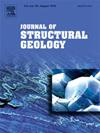Multi-phase deformation in the Qixingtai region of Western Shandong Province: insights into the Neoarchean tectonic evolution of the eastern North China Craton
IF 2.9
2区 地球科学
Q2 GEOSCIENCES, MULTIDISCIPLINARY
引用次数: 0
Abstract
The Neoarchean era marks a pivotal period in Earth's tectonic evolution and continental crust formation. In this context, crustal architecture and structural patterns serve as key indicators for reconstructing Neoarchean geodynamic processes. The Western Shandong Province (WSP) granite-greenstone belt, located in the North China Craton (NCC), preserves well-exposed Neoarchean rock assemblages and provides valuable insights into the Neoarchean tectonics. In this study, we conducted systematic geological mapping and detailed structural analysis, integrated with LA-ICP-MS zircon U-Pb geochronology, in the Qixingtai region of the WSP. Three stages of compressional deformation (D1 to D3) were identified. The earliest deformation D1, predating ∼2663 Ma, is characterized by NW-SE-trending, sub-vertically penetrative S1 foliation in early Neoarchean supracrustal rocks and TTG rocks, indicating an initial NE-SW compressional regime. This was followed by a regional extension during 2.60-2.55 Ga and deposition of the Shancaoyu Formation during 2.55-2.52 Ga. The subsequent deformation D2 (∼2520-2514 Ma) progressively overprinted earlier structures and generated NW-SE-trending upright isoclinal folds in late Neoarchean supracrustal and TTG rocks, indicating a consistent and prolonged compressive stress field. The last deformation D3, occurring around ∼2500 Ma, resulted in the development of ductile shear zones of variable scales along the major lithological boundaries and generated regional L-S tectonites with near-vertical foliation and horizontal lineation. Our results suggest that the WSP experienced a long-lasting NE–SW compressive stress field throughout the Neoarchean but lacks diagnostic features of typical subduction or collisional belts. Combined with previous studies, we propose a tectonic model for the tectonic evolution of the Qixingtai area. This area initially developed from an oceanic plateau in the early Neoarchean, experienced regional extension in the middle Neoarchean, and ultimately underwent extensive magmatism and horizontal shortening during the late Neoarchean.
鲁西七星台地区多期变形:华北克拉通东部新太古代构造演化的启示
新太古代是地球构造演化和大陆地壳形成的关键时期。在此背景下,地壳结构和构造模式是重建新太古代地球动力学过程的关键指标。鲁西花岗岩-绿岩带位于华北克拉通(NCC),保存了暴露良好的新太古代岩石组合,为研究新太古代构造提供了有价值的信息。本研究结合LA-ICP-MS锆石U-Pb年代学,对WSP七星台地区进行了系统的地质填图和详细的构造分析。确定了3个挤压变形阶段(D1 ~ D3)。最早的变形D1,在~ 2663 Ma之前,在新太古代早期的表壳岩石和TTG岩石中表现为nw - se走向的、亚垂直渗透的S1片理作用,表明初始的NE-SW挤压状态。2.60 ~ 2.55 Ga为区域伸展期,2.55 ~ 2.52 Ga为山草峪组沉积期。随后的D2变形(~ 2520 ~ 2514 Ma)逐渐叠加了早期的构造,在新太古代晚期的上地壳和TTG岩石中形成了nw - se向的直立等斜褶皱,表明了一个一致的、延长的压应力场。最后一次变形D3发生在~ 2500 Ma左右,导致沿主要岩性边界发育变尺度韧性剪切带,并形成了具有近垂直面理和水平线理的区域性L-S构造岩。我们的研究结果表明,在整个新太古代,WSP经历了一个长期的NE-SW压应力场,但缺乏典型的俯冲带或碰撞带的诊断特征。结合前人研究,提出了七星台地区构造演化的构造模式。该地区在新太古代早期由海洋高原发育,在新太古代中期经历了区域伸展,最终在新太古代晚期经历了广泛的岩浆作用和水平缩短。
本文章由计算机程序翻译,如有差异,请以英文原文为准。
求助全文
约1分钟内获得全文
求助全文
来源期刊

Journal of Structural Geology
地学-地球科学综合
CiteScore
6.00
自引率
19.40%
发文量
192
审稿时长
15.7 weeks
期刊介绍:
The Journal of Structural Geology publishes process-oriented investigations about structural geology using appropriate combinations of analog and digital field data, seismic reflection data, satellite-derived data, geometric analysis, kinematic analysis, laboratory experiments, computer visualizations, and analogue or numerical modelling on all scales. Contributions are encouraged to draw perspectives from rheology, rock mechanics, geophysics,metamorphism, sedimentology, petroleum geology, economic geology, geodynamics, planetary geology, tectonics and neotectonics to provide a more powerful understanding of deformation processes and systems. Given the visual nature of the discipline, supplementary materials that portray the data and analysis in 3-D or quasi 3-D manners, including the use of videos, and/or graphical abstracts can significantly strengthen the impact of contributions.
 求助内容:
求助内容: 应助结果提醒方式:
应助结果提醒方式:


